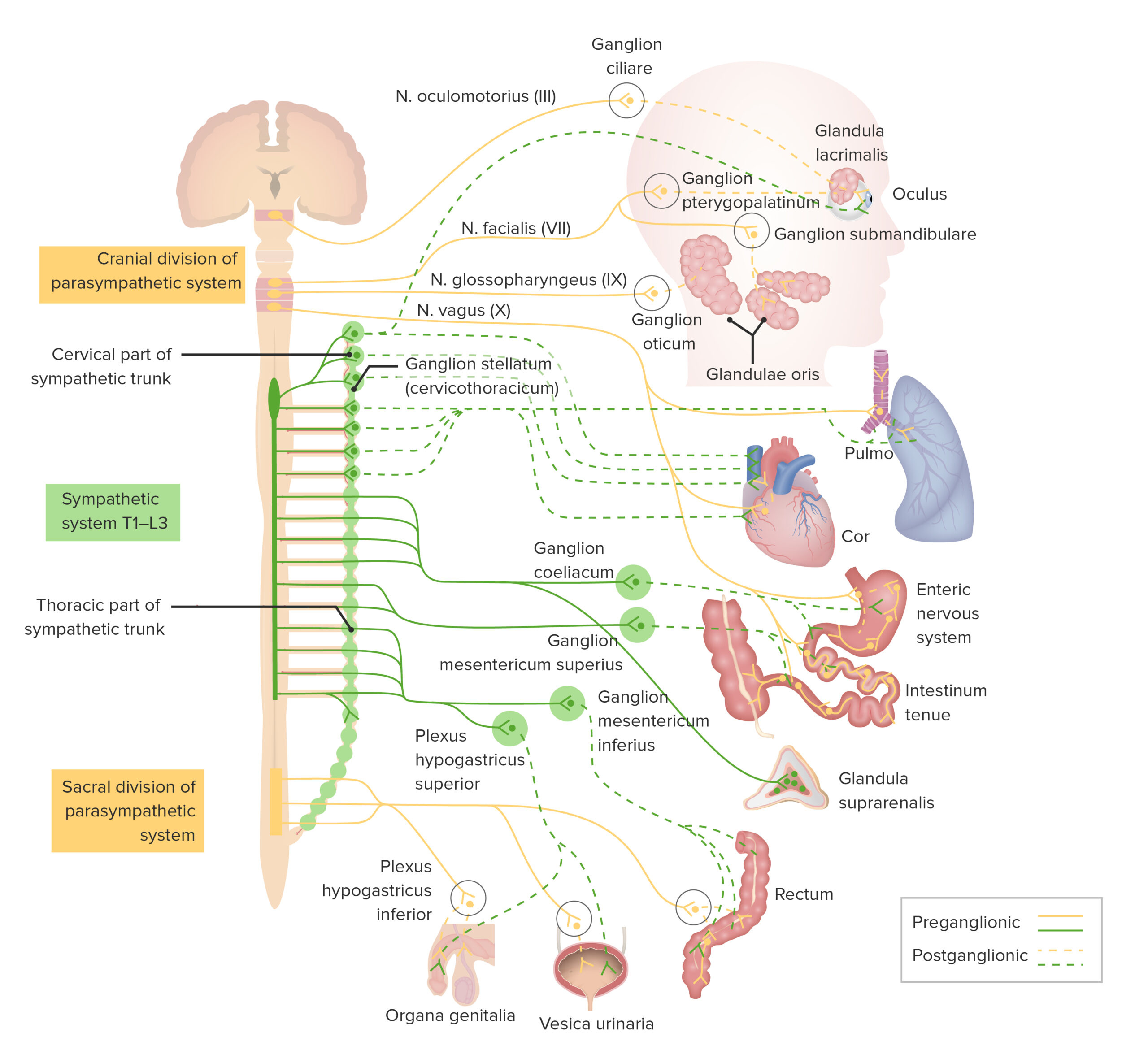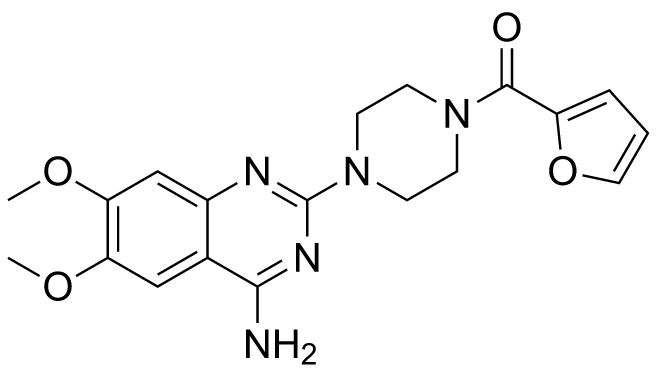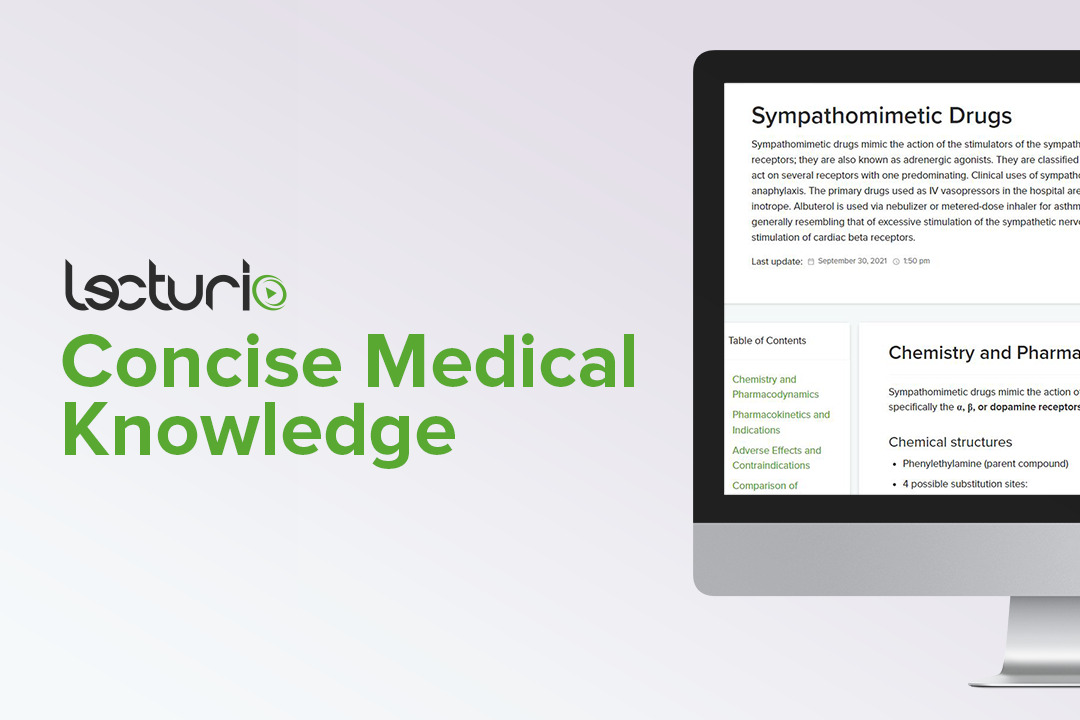Playlist
Show Playlist
Hide Playlist
Sympathomimetic Activators
-
Slides Sympathomimetic Activators.pdf
-
Reference List Pharmacology.pdf
-
Download Lecture Overview
00:01 Hi, welcome to pharmacology by Lecturio. We are going to continue our journey talking about the autonomic nervous system and the drugs that we use to control it. My name is Dr. Pravin Shukle. 00:15 The sympathetic nervous system regulates organ systems, especially in stress, for "fight or flight”. 00:20 Sympathomimetic drugs mimic neurotransmitters like epinephrine and norepinephrine. 00:25 They're categorized by mode of action and receptor influence. Direct agonists bind to adrenergic receptors, e.g., norepinephrine and epinephrine. 00:35 Indirect agonists enhance endogenous catecholamines via various mechanisms: inducing release (for example, amphetamines), inhibiting clearance (for example, cocaine), and blocking enzymatic metabolism (for example, MAO and COMT inhibitors). 00:51 Some drugs act both ways, broadening therapeutic options. 00:56 Sympathomimetic drugs directly activate adrenergic receptors. 01:00 Alpha agonists like phenylephrine target α₁ receptors for vasoconstriction, while clonidine acts on α₂ receptors for hypertension. 01:08 Mixed alpha and beta agonists like Norepinephrine balance their effects between alpha and beta receptors, useful in acute situations. 01:18 Epinephrine acts on all adrenergic receptors, crucial in emergencies. Beta-agonists like dobutamine predominantly stimulate β₁ over β₂ and have minimal alpha effects. 01:32 This makes dobutamine an excellent choice for heart failure treatment. 01:36 Isoproterenol equally stimulates both β₁ and β₂ without influencing alpha receptors. 01:43 Albuterol targets β₂, so it is ideal for bronchodilation in asthma. 01:48 Dopamine agonists affect the cardiovascular system based on dosage: vasodilation at low doses, increased heart rate at moderate doses, and vasoconstriction at high doses. 01:59 Remember that alpha-1 receptors cause vasoconstriction, beta-1 increases heart rate and contractility, and beta-2 leads to vasodilation. 02:09 Indirect-acting sympathomimetic enhance neurotransmitter activity. 02:13 Amphetamine-like displacers, like amphetamine and methylphenidate, push out stored catecholamines, boosting CNS function. 02:21 Tyramine, found in fermented foods, can raise blood pressure if MAO activity is inhibited. 02:28 Catecholamine reuptake inhibitors, such as tricyclic antidepressants and atomoxetine, block neurotransmitter reuptake, affecting mood and emotional state. 02:41 Atomoxetine specifically targets the norepinephrine transporter and is used in treating ADHD. 02:47 Cocaine inhibits dopamine reuptake, causing euphoria. 02:51 Dopamine agonists manage Parkinson disease. 02:54 Levodopa is a precursor to dopamine that can cross the blood- brain barrier and is converted into dopamine. 03:01 If you remember I gave you a picture of the terminal nerve button of both the cholinergic and the adrenergic nerve. Let's take a look in more detail at the production of norepinephrine in the adrenergic terminal nerve button. We start with tyrosine. Tyrosine is converted by a hydrolase into dopa and dopa is converted into dopamine. Now dopamine also undergoes a chemical reaction and during that chemical reaction it is also packaged into vesicles. The chemical reaction converts it into norepinephrine and that norepinephrine is stored in this vesicles or bags of enzymes. The norepinephrine vesicle is kept at the end of the terminal nerve button until it's needed. 03:47 And when there is a signal from the nerve, that signal is usually calcium, the norepinephrine is released into the synaptic cleft. Now you need calcium in order for that synaptic cleft, sorry for the vesicle to bind with the membrane and release into the synaptic cleft. Okay, so now your norepinephrine is in the synaptic cleft. There is 1 of 3 things to norepinephrine now. It will either be diffused away, or metabolized and therefore made inactive or it will activate the adrenoreceptor itself and cause an effect. Or it will get reuptaken. So reuptake is usually mediated through the norepinephrine transport molecule and you can see it there it just appeared. Now, we do have inhibitors of that NET molecule. 04:40 That's tricyclic antidepressants and cocaine. So cocaine inhibits the transport molecule leaving more epinephrine in the synaptic cleft and that's how you get the hyperadrenergic response with cocaine. Now incidentaly in the brain tricyclic antidepressant do have this effect as well and that's why you have a reduction in depression in some cases.
About the Lecture
The lecture Sympathomimetic Activators by Pravin Shukle, MD is from the course ANS - Pharmacology.
Included Quiz Questions
What is LEAST likely to activate beta-adrenergic receptors?
- Phenylephrine
- Epinephrine
- Intermediate dose dopamine
- Dobutamine
- Isoproterenol
Which of the following is the correct association of the drug with its specificity as an alpha agonist?
- Phenylephrine - Alpha 1 selective agonist
- Clonidine - Beta 2 selective agonist
- Isoproterenol - Alpha 2 selective agent
- Dobutamine - Non-selective alpha agent
- Norepinephrine - Beta 1 selective agonist
Customer reviews
5,0 of 5 stars
| 5 Stars |
|
5 |
| 4 Stars |
|
0 |
| 3 Stars |
|
0 |
| 2 Stars |
|
0 |
| 1 Star |
|
0 |






